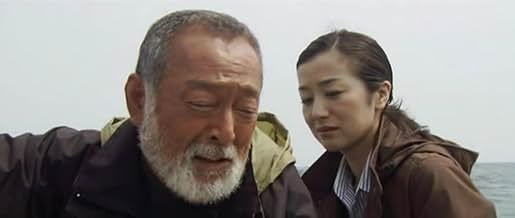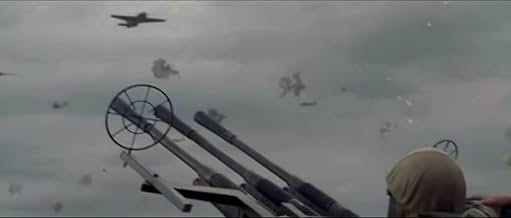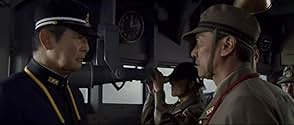Aggiungi una trama nella tua linguaThe movie follows 3 Japanese friends from embarking on Yamato, the world's largest battleship, until it's sunk 3 1/2 years later on April 7, 1945 on it's way to Okinawa to stop American adva... Leggi tuttoThe movie follows 3 Japanese friends from embarking on Yamato, the world's largest battleship, until it's sunk 3 1/2 years later on April 7, 1945 on it's way to Okinawa to stop American advance at the end of WWII.The movie follows 3 Japanese friends from embarking on Yamato, the world's largest battleship, until it's sunk 3 1/2 years later on April 7, 1945 on it's way to Okinawa to stop American advance at the end of WWII.
- Premi
- 6 vittorie e 7 candidature totali
- Atsushi
- (as Sosuke Ikematsu)
Recensioni in evidenza
I found myself with tears in my eyes from the very beginning, because it was as if all the black and white photographs I have been generously shown by these families were coming to life--the young faces of these sailors, frightened, proud, and eager to live up to their responsibilities, were very true to what I sense was really happening in the 1940s.
I have to say, unlike the very propagandist flavor of many American films about the Pacific War, including most recently 'Pearl Harbor,' this film really delves into the traumatic aspects of masculinity in general and having to live up to "being a man" in Japan just as much as it celebrates the humanity of the people involved. Many American films, with the exception of 'Saving Private Ryan' and several films about Vietnam, tend to stick to very comic-like stark depictions of heroes and villains and an overall sense of being "victimized" by the enemy. Here, the enemy is not the United States but rather masculinity and male pride itself, as well as the whole tragic story they create.
As such, it is a welcome remedy to way too much American-biased victory narratives that obscure the face of the Japanese military, and to films that portray menacing, dehumanized battalions of Japanese soldiers advancing forth without any legitimate context of their own. We see in this film the faces of these young men and understand what situation they were coming from.
That said, clearly the film was trying to be sensitive to war bereaved and to the official narratives of Japanese pretexts for war, and in that sense I feel they overdid it a little. We don't get a sense, for instance, about Japan's colonial presence throughout Asia and the Pacific--only the vague notion that Japan somehow got involved in war. Still, this isn't really a film about why the war happened, but rather about how it was to live and fight in the immediate time preceding Japanese surrender. In that sense, I do want to make the critique that this film really could have done with even MORE contextualization and solid research of popular Japanese culture at the time, because this would have added even more to its convincing sense of reality. For instance, the soundtrack would have been greatly enhanced with some of the evocative marching music and the ballads on the radio in the 1930s and 1940s that encouraged young men to join the navy and go south to the South Seas.
These songs are still sung even by the bereaved families who go back to visit the places where their loved ones died, so it would have been quite powerful if we got to hear them throughout the film. The absence of small details like this, some rather poorly-imitated Japanese regional dialects, and some of the melodramatic overacting by a few members of the cast, detracted somewhat from the overall production. But in general, this is a very fine film, extremely well acted (and compassionately so) by its cast.
I have been reading a book about the film in Japanese and it's fascinating to learn how so many of the cast worked directly with Japanese veterans and the bereaved families in order to develop their characters and their behavior. So in many respects this film is not only based on the realities of battle (which are really just the backdrop) but on the real life realities of war and on being a young man in the Japanese Imperial Navy in 1944-1945.
In all, it's an extremely meaningful film that needs to be distributed widely through the world. I know there is a lot of resistance to its release in China and Korea, understandably, but I think this is a portrait of what was going on for Japanese at the time and as such could even work as a tool to facilitate better understanding in these countries. It is essential that more compassionate films like this are made that go on to address the complexity and horror of what happened in Asia and the Pacific-- to the people whose lives were colonized and ruined by Japanese aggression, but at least it's a start. It appears to me that Japanese popular culture is finally ready to address the war in all of its ugliness and begin to heal some of these old wounds.
The human story inside the story also is moving.
The major flaw of it, is that is too long. It gets unnecessary and frequently lost in details.
This film shows People. People in tragic times. People fighting for their loves and their lives. Whether it is Yamato, Saving Private Ryan, The Thin Red Line, Brotherhood, Stone's trilogy, Eastwood's duo of films, etc, it comes down to people trying to live. So much has been said about the film that is political but I ask you, what is the point of doing so for a film that strove so hard to in favour of a human story? After years of revisionist Hollywood war films, it is ironic that this moving film, Yamato, be raked over coals for inaccuracies or romanticism.
Besides this, however, and a technical note, the film's visual effects are excellent for a non-Hollywood film. I wouldn't be surprised if Yamato was one of the most expensive Japanese films ever made. While making an ocean going battleship replica was not an option, the sets, miniatures and CGI create a very gritty and realistic feeling of being aboard the fated ship.
Musically the film is also very striking and has some memorable themes throughout. The sound track is also superb with excellent separation in the 5.1 channels. The battle scenes are especially vivid in their aural presentation.
The amount of heart, work and effort that went into the film is clear from the exceptional cast, sound and competent visuals and their passionate and honest performances and work. This is definitely a film for the world to see. It is not a war film about "war"; it is a film about love. The message rings loud and clear until the final note of the closing credit's song.
The mission accomplished nothing but another one-sided slaughter of "obedient soldiers". This is the real tragedy of men educated for obedience. Germans and Japanese alike.
And they were killed with millions against overwhelming (and technically also superior) powers by an opportunistic and docile dictatorship, leaving behind millions of sorrowing wives and children which never saw much of their fathers.
Otoko-tachi no Yamato shows us the common Japanese soldiers as human beings. No propaganda at all, unlike so many US war movies.
Its counterpart was the German movie "Das Boot". The difference is that in Germany the process of showing World War II as it was started earlier than in Japan. Even the horrendous loss of the Wilhelm Gustloff (10.000 dead)has been shown in a movie on the German television recently. In Japan the horrors of WWII finally are being shown to the public. While Germany feels "very guilty" for many decades, this process in Japan not really has been started yet.
I am not racist nor nationalist. I also am not right wing. I oppose to any wars by any mean. But, I respect the men who fought for us and it is sad that we don't know much about the fact we are living on where these men protected.
I voted this as "5" for actors/actress are not that super... Theme song as the same... Understanding they did their best, but level of acting is miserable. The battle scenes are great.
Sometime it's too stereotype to illustrate the story (ie. Geisha & Japanese Gamble ... that's almost the all the Japanese movie does).
Lo sapevi?
- QuizPart of the foredeck and port side of the Yamato were reconstructed to full scale for the exterior scenes. As the Japan Building Standards Act interfered with re-creating the ship's entire superstructure, images of a one-tenth scale model of the Yamato at its namesake museum in Kure were used in post-production.
- BlooperThe ship is seen firing salvos from its main batteries aimed at approaching US aircraft on several occasions, while lots of the crew are visible on deck, manning the light AA guns as well as performing other duties. While the big guns were in fact used fending off aircraft, at least during the last battle off Okinawa, the shock wave from the blast of the nine 460 mm barrels (the biggest ever on a warship) could kill or severely injure an unprotected sailor, it was therefore forbidden to remain on deck on such occasions.
- Citazioni
Mamoru Uchida: [Firing an AA gun defiantly as the ship sinks] I'm not done yet! My last throw!
I più visti
- How long is Yamato?Powered by Alexa
Dettagli
Botteghino
- Lordo in tutto il mondo
- 39.287.114 USD
- Tempo di esecuzione2 ore 25 minuti
- Colore
- Mix di suoni
- Proporzioni
- 2.35 : 1
Contribuisci a questa pagina












